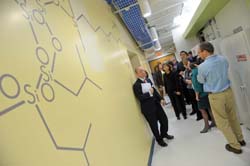Syracuse Views Fall 2025
We want to know how you experience Syracuse University. Take a photo and share it with us. We select photos from a variety of sources. Submit photos of your University experience by sending them directly to Syracuse University News at…

 “The Syracuse Biomaterials Institute embodies the cross-disciplinary and cross-sector connections that define research, innovation and education in the life sciences today,” says Cantor. “Bowne Hall originally was built for just one department—chemistry—but our renovation of it for SBI not only makes it perfectly suited to the task of fostering collaboration, but makes it an emblem of the evolution of discovery in science, engineering and medicine.”
“The Syracuse Biomaterials Institute embodies the cross-disciplinary and cross-sector connections that define research, innovation and education in the life sciences today,” says Cantor. “Bowne Hall originally was built for just one department—chemistry—but our renovation of it for SBI not only makes it perfectly suited to the task of fostering collaboration, but makes it an emblem of the evolution of discovery in science, engineering and medicine.”